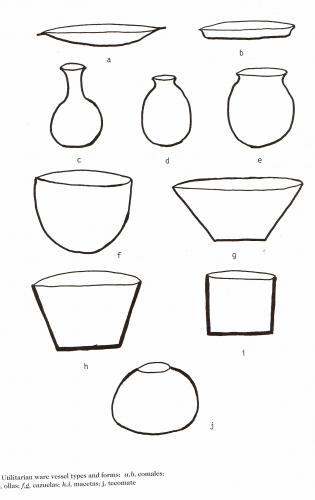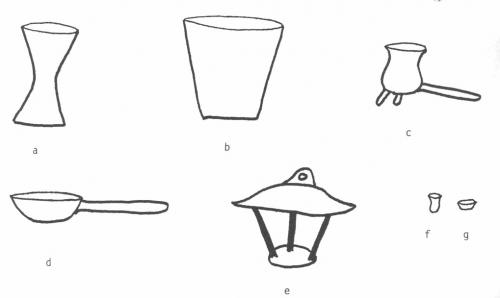Vessel Form Analysis
By Geoffrey McCafferty (2008)
The identification of the UA-1 vessel forms is based on ethnographic analogy with pottery in use in contemporary Mexico, and is consistent with ethnohistoric evidence for pottery in use at the time of the Conquest. Three functional classes of vessels are recognized: utilitarian wares, serving wares, and ceremonial wares (Table 3). Within each of these classes there occur several functional types of vessels; for example, serving wares consist of platos, cajetes, and copas. Specific vessel forms relate to these functional types, and are sub-divided based on such attributes as standardized morphology, size, or rim dimension. Vessel forms are often described in relation to idealized geometric shapes (Fig. 1). A total of 24 separate vessel forms are distinguished, with nine possible variations in rim or lip form.

Figure 1: Idealized ceramic forms
VESSEL FORMS AND RIM FORMS
UTILITARIAN WARES SERVING WARES
COMAL PLATO
Comal Plate/lid
Vertical Rim Comal Outleaned Wall Dish
flared rim
OLLA Subhemispherical Dish
Long Neck Olla
everted L-lip CAJETE
Small Mouth Olla Outleaned Wall Bowl
Large Mouth Olla everted lip
Subhemispherical Bowl
CAZUELA everted L-lip
Hemispherical Cazuela Hemispherical Bowl
flared rim flared rim
Conical Cazuela Conical Bowl
flared rim impressed rim
everted lip flared rim
bolstered lip everted lip
Cylindrical Bowl
MACETA flared rim
Conical Maceta everted lip
Cylindrical Maceta Superhemispherical Bowl
TECOMATE COPA
Tecomate Biconical Copa
inverted rim
vertical rim
CEREMONIAL WARES
BRASERO
TRIPOD CENSER
SAHUMADOR
LANTERN CENSER
MINIATURE VESSEL
Utilitarian ware vessels were generally used in food preparation and storage. Five vessel types are recognized: comales, ollas, cazuelas, macetas, and tecomates (Fig. 2).
Comales (griddles) are wide, low vessels that were used to heat tortillas and other dry foods over a hearth fire. The interior surface is usually burnished, but the exterior surface is very coarse, probably even intentionally roughened to enhance the transfer of heat and prevent slippage on the hearth stones. Rims are generally bolstered, sometimes with an exterior flange that looks like a base. Although there is considerable variation in rim forms the only consistent pattern found was in vertical rims which project 1-3 cm above the body of the vessel. These are probably a temporal variant dating to the Epiclassic period. Other than the bolstered rims, vessel walls range from very thin to medium thickness depending on the ceramic type.
Ollas (jars) are large, globular vessels with a constricted orifice and flaring neck. They were used for storing and heating liquid foods. While the exterior is usually at least smoothed, the interior is unfinished or simply wiped. The exterior base is often blackened from exposure to heating fires, and interiors occasionally have sediments relating to the substances stored or processed in the containers. Bases are rounded, requiring a ring-stand for support on the ground. Handles are often located on the vessel neck and/or shoulder, indicating that they may also have been suspended above the ground. Three vessel forms were identified on the basis of the orifice dimensions: long neck ollas, small mouth ollas, and wide mouth ollas.

Cazuelas (cooking pots) are large, open vessels that were used for cooking foods of stew-like consistency (e.g., mole). Surface treatment consists of smoothing on both the interior and exterior, with the interior usually more carefully finished. Examples have fairly thick vessel walls, and handles are found at the rim. No rim-to-base sherds were recovered at UA-1, but ethnographic examples and those illustrated in the codices have flat bottoms. Vessel forms include hemispherical cazuelas and conical cazuelas.
Macetas (basins) are large, thick wall vessels that may have been used for storage. They are open vessels that can be distinguished from cazuelas by the thickness of the vessel walls, and by the presence of a roughened bottom similar to that on comales. Vessel forms include conical macetas and cylindrical macetas.
Tecomates (constricted mouth jars) are large, superhemispherical vessels with a relatively small orifice. The exterior surface generally has a better finish than the interior, which is simply wiped. These are usually fairly tall vessels that were probably used for storage but tend not to have handles.
Serving wares were generally used for food consumption, although some exceptions will be discussed. Three vessel types are recognized: platos, cajetes, and copas (Fig. 3).

Figure 3: Serving ware vessel types
Platos (plates) are defined as wide, low vessels that were probably used for the consumption of dry foods. They have either flat bases or slightly raised centers, and the most common vessel form (flared rim outleaned wall dish) has a low wall that includes a wide, horizontal rim. Some examples include tripod supports, but this was rare in the UA-1 assemblage. They were often elaborately decorated and well-burnished on the interior surface, but with minimal decoration on the exterior. Other vessel forms include plates/lids and subhemispherical dishes.
Cajetes (bowls) are relatively deep vessels that were probably used for the consumption of liquid foods. They usually have flat or flattened bases, and tripod supports are common. Very elaborate polychrome bowls occasionally have a tall ring base, giving the vessel an hourglass appearance. Cajetes are often decorated on the interior and/or exterior depending on the specific vessel form. This was the most abundant vessel type found at UA-1, and vessel forms include: outleaned wall bowls, subhemispherical bowls, hemispherical bowls, conical bowls, cylindrical bowls, and superhemispherical bowls.
In addition to their primary function in food consumption, several varieties of cajetes had alternative uses. Molcajetes, for example, had a stamp-impressed interior base that created an abrasive surface used for grating chiles (McCafferty and Suárez 2001). Ethnohistoric evidence indicates that small bowls were used for supported spinning (cf. Smith and Hirth 1988), and bowls with heavily worn interior bases were found at UA-1 that might indicate such a function. A number of very small Momoxpan Orange bowls were found as grave goods in a mass burial in San Andrés Cholula (Suárez C. 1989), and their association with spindle whorls suggests the possibility that they may have functioned as spinning bowls (McCafferty 1992b). Finally, some of the superhemispherical bowls showed evidence of firing discoloration, suggesting that they may have been used over a fire, perhaps to heat food. Since evidence for alternative uses for cajetes usually requires a relatively complete vessel fragment, no attempt is made to separate these from the serving ware class. It should be noted, however, that there is some ambiguity in this category.
Copas (cups) are defined as tall vessels with a relatively small rim diameter. They were probably used for the consumption of beverages, possibly pulque (fermented maguey juice) or chocolate. The most common vessel form was the biconical copa, with a tall ring base giving the vessel an hourglass shape. Decoration appears on the exterior surface, which is usually well-burnished. The interior of the upper section is more carefully finished than the interior of the base, which is usually just smoothed.
Ceremonial wares were used for ritual practice, especially for the burning of incense. Ethnohistoric sources describe a range of contexts in which ceremonial wares might be used, including domestic rituals. Ceremonial wares included: braseros, tripod censers, sahumadores, lantern censers, and miniature vessels (Fig. 4).

Figure 4: Ceremonial vessel types
Braseros, including xantiles, are large vessels that were probably used for burning incense. They may have played a special role in domestic ritual associated with a household altar (Sisson 1992). They are usually thick walled, and were often coarsely constructed. Three nearly complete braseros recovered from the "brasero niche" in Room 3 of Structure 1 were biconical vessels, measuring about 30 cm in height (Fig. 14). Two had anthropomorphic figures appliquéd onto the exterior. Other braseros are decorated with stucco and then painted in colors that include blue and black. Some braseros have appliqué braiding on the exterior, and others have pinched cones that protrude from the exterior vessel walls.
Tripod censers are small globular vessels that resemble miniature ollas. They are supported on two short legs, with a third, longer support that probably also served as a handle. These censers are usually highly burnished on the exterior, but plain and fire blackened on the interior. A common decorative form is a lattice-work pattern created by carving away sections of the vessel wall to allow the smoke to escape through the sides.
Sahumadores resemble frying pans in that they have a shallow dish that is connected at the rim to a long handle. They were used for burning incense, especially during processions. The exterior of the vessel and handle are usually well burnished, but the interior of the bowl is plain and fire-blackened. The handles are hollow, and complete examples occasionally have zoomorphic figures attached at the end (Müller 1978:166-167, plate 22).
Lantern censers are constructed of a flat, circular base, a domed roof, and three cylindrical supports that attach the roof to the base. Fire-blackening on the interior surface of the roof indicates that incense was probably burned on the base, with the smoke rising to coat the inside of the roof. A loop handle on top of the roof provided a means for suspending the censer. These censers were generally undecorated other than occasional incised cross-hatching on the outer surface of the roof, giving it the appearance of a thatched roof.
Another censer type that was not found in the UA-1 assemblage, but that occurred in the UA-79 Late Postclassic assemblage, consists of a conical bowl with two solid handles projecting out from either side of the vessel. These handles are often pierced by a round hole that passes from top to bottom, providing a means to suspend the censer. These vessels are usually highly decorated with elaborate polychrome motifs on the exterior, but are plain and fire-blackened on the interior.
Miniature vessels are a final type of ceremonial ware found on rare occasions at Cholula. They are usually less than 10 cm in height and 5 cm in diameter, and often resemble ollas. It is unclear how they were used within a domestic context, but they do appear in mortuary assemblages at the ceremonial center of Cholula (López A., Lagunas R., and Serrano S. 1976). Miniature vessels are relatively abundant in Postclassic contexts from the Mixteca Alta (Spores 1972; Lind 1987).
A comparative analysis of vessel form frequencies is used to identify potentially different activity areas and/or patterns of disposal. When factored into the diachronic sequence produced by the ceramic seriation, variations in vessel form may be used to interpret changes in cultural foodways. Finally, the ratios of vessel class and vessel type provide a basis for comparison with other assemblages.

